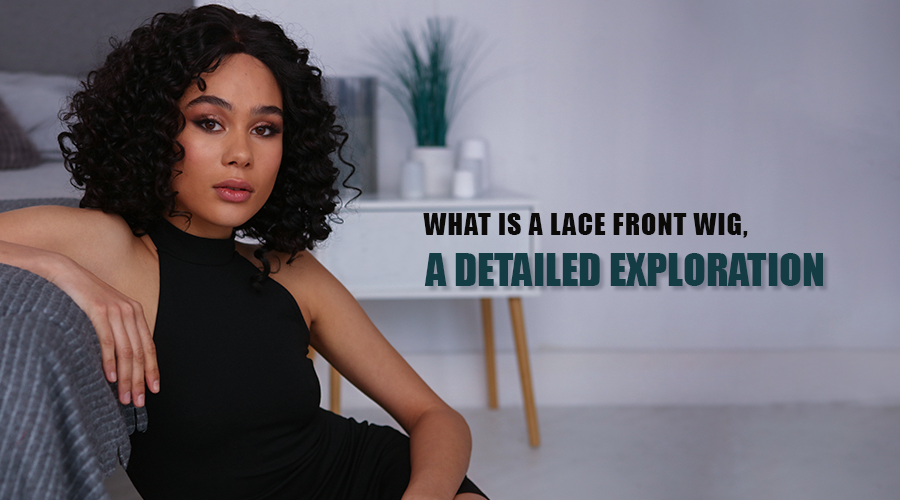What is a Lace Front Wig, A Detailed Exploration

Choosing the right wig depends on the desired appearance, budget, comfort, and styling preferences. Whether for daily wear, special occasions, or cosplay events, the wide variety of wigs available ensures that there’s an option for everyone.
However, among all these wigs, lace front wigs have gained immense popularity for their natural appearance and customizable features. In this detailed exploration, we will delve into the intricacies of lace front wigs, understanding their construction, application, and the artistic touch they bring to the world of hair fashion.
What is a Lace Front Wig?
A lace front wig is a wig style with a sheer lace or mesh base at the front that extends from ear to ear. The objective of this lace front is to mirror the natural hairline, producing a realistic and smooth look while the wig is worn. The rest of the wig is often made of materials such as synthetic fibers or human hair, depending on the desired quality and budget. The key features of a lace front wig are listed below:
Lace Material
The front of the wig is made with fine lace, usually either Swiss lace or French lace. These lace materials are chosen for their delicate and breathable nature, ensuring a comfortable feel when the wig is worn.
Hair Attachment
The hair on lace front wigs can be made from synthetic fibers or human hair. Synthetic lace front wigs are often made from high-quality synthetic materials that imitate the texture and appearance of natural hair. On the other hand, human hair lace front wigs provide the most authentic look and feel, allowing for styling versatility similar to one’s hair.
Adjustability
It is the process of individually knotting each hair strand into the lace, creating a more natural appearance. This meticulous technique allows the hair to move and fall like real hair, contributing to the overall realism of the wig.
Cap Construction

The cap construction of a lace front wig plays a crucial role in determining its comfort, stability, and overall appearance. While the lace front section is a defining feature, the rest of the cap can be constructed in various ways. Here’s an overview of the cap construction of a lace front wig:
Cap Base
The cap base is the foundation of the wig and can be constructed from various materials. Common materials include breathable mesh, nylon, or other lightweight fabrics.
Construction
The cap can be machine-sewn or hand-tied, with the latter being more labor-intensive and offering a more natural look. Hand-tied caps allow for more movement and flexibility of the hair.
Versatility
Many lace front wigs have adjustable straps or hooks at the nape of the neck to provide a secure fit and accommodate different head sizes.
Types of Lace Front Wigs

Full Lace Front Wigs
In these wigs, the entire base is made of lace, offering the ultimate in styling flexibility. The wearer can part the hair in any direction, and the wig can be styled into updos or ponytails without revealing the wig’s true nature.
Lace Frontal Wigs
These wigs feature lace only at the front, from ear to ear, providing a natural-looking hairline. The rest of the wig is constructed with a more traditional cap. Lace frontal wigs are popular for their balance between natural appearance and affordability.
360 Lace Front Wigs
With lace that extends around the entire perimeter, these wigs allow for a full range of styling options. They are particularly well-suited for high ponytails and updos, as the lace wraps around the head.
Application
Wearing a lace front wig involves preparing the natural hair, securing it close to the scalp with a wig cap or braiding, and then applying the wig using adhesives or tapes. The lace front is carefully positioned along the natural hairline, creating a seamless blend between the wig and the wearer’s hair.
Advantages
- The sheer lace at the front mimics the appearance of a natural hairline, making it challenging for others to distinguish between the wig and natural hair.
- Lace front wigs offer a wide range of styling options, from parting the hair in different directions to creating intricate hairstyles like updos and ponytails.
- The lace material allows for better airflow, preventing the scalp from becoming too hot or uncomfortable during extended wear.
- Lace front wigs are designed to conform to the shape of the wearer’s head, providing a secure and comfortable fit.
- When correctly cared for, lace front wigs can be long-lasting and withstand regular styling and maintenance.
Maintenance

Proper maintenance is crucial to keep a lace front wig looking its best and to ensure its longevity. Here are essential tips for maintaining a lace front wig:
Daily Care
- Use a wide-tooth comb or a wig brush to detangle the hair gently, starting from the tips and working your way up to the roots.
- Hold the wig at the base to prevent unnecessary tension on the lace.
- Avoid wearing the wig every day to reduce wear and tear.
- Give your natural hair and scalp a break by allowing some days without wearing the wig.
Washing
- Wash the wig when it is visibly soiled or after about 10-15 wears.
- Excessive washing can lead to wear, so it’s essential to find a balance.
Detangling & Shampooing
- Gently detangle the hair before washing to prevent knots and tangles during the washing process.
- Use a wig-friendly shampoo that is sulfate-free and formulated for synthetic or human hair, depending on the wig type.
- Gently wash the hair in a downward motion, avoiding rubbing or twisting.
Conditioning
- Apply a wig conditioner to the mid-lengths and ends, avoiding the roots.
- Use a wide-tooth comb to distribute the conditioner evenly.
- Let the conditioner sit for a few minutes before rinsing.
Drying
- Pat the wig with a towel to remove excess water.
- Place the wig on a wig stand or mannequin head to air dry.
- Avoid wringing or twisting the wig, as this can damage the hair fibers.
Heat Styling
- Be gentle when styling and avoid excessive tension on the hair and lace.
- Use styling products designed for wigs to minimize damage.
Nighttime Care
- Before going to bed, braid or wrap the wig to prevent tangling.
- Use a satin or silk scarf or sleep on a satin pillowcase to reduce friction.
Storage
- Store the wig on a wig stand or mannequin head when not in use.
- Keep it away from direct sunlight to prevent color fading.
Cleaning
- Use a small, soft brush or toothbrush to clean the lace by gently removing any makeup or adhesive residue.
- Be cautious not to tear or damage the delicate lace.
Professional Maintenance
- If you’re unsure about maintaining the wig yourself, consider taking it to a professional wig stylist for regular checkups and maintenance.
Final Thoughts
In the grand tapestry of hairstyling, lace front wigs are a testament to the marriage of artistry and innovation. From their intricately crafted lace bases to their limitless styling possibilities, these wigs have transcended the boundaries of conventional beauty, offering a canvas for self-expression and empowerment. As we continue to witness the cultural impact of lace front wigs, it becomes evident that they are not merely accessories; they are transformative tools that redefine how we perceive and celebrate the beauty of diversity in hair. So, whether you’re a seasoned wig enthusiast or considering venturing into the world of lace front wigs, embrace the artistry, versatility, and cultural significance these wigs bring to the forefront of beauty and style.






